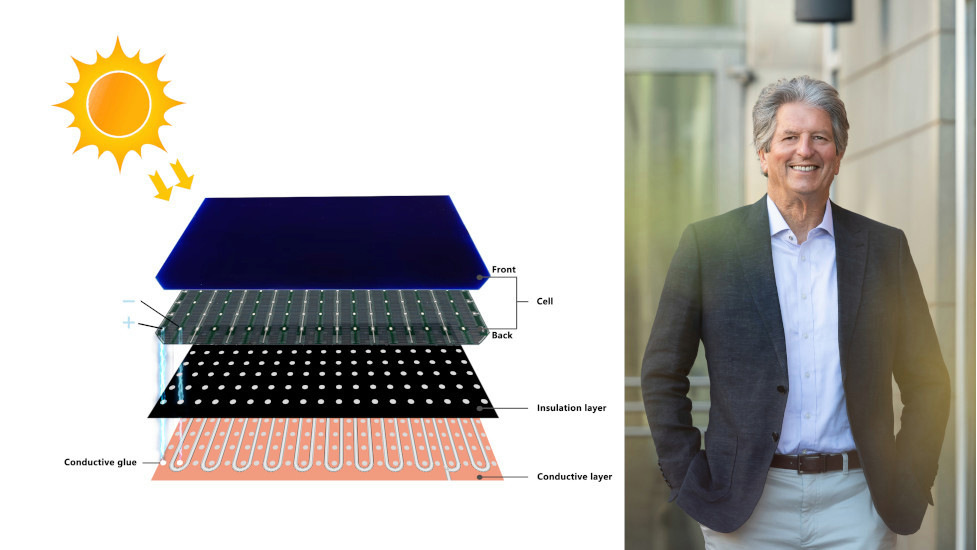There are already light modules on the market, but the euro energy follows a new path. What kind of solar cells do you use in your modules?
Martin Green: We use interdigitated backstact cells – IBC technology.
Why do you use this specific cell technology?
You have both contacts on the back of the cell. That gives us the highest possible efficiency. Because there is no shading of the cell, as with the contacts on the front. These backstact cells have no metal pattern on the front and are aesthetically beautiful. They are very appealing and offer them an excellent performance.
Stay up to date with the solar energy transfer and subscribe to our free newsletter.
The structure of the modules is also new. They use the so-called planar electrical connection or the PEC technology. Can you tell us about it?
With the PEC technology, the cells are contacted via a copper leaf at the back. This flexible copper leaf on the back and not on the bands used with conventional modules is a unique way to contact the cells that are particularly suitable for these back -contact cells. This is a very thin film and it is patterned.
Why does that have to be patterned?
Due to the structured structure, the cell can be contacted in the correct areas to contact the two different polarities separately and then connect all cells in the module in series so that they build up the voltage of the module. Cells result in a very high current, but a fairly low voltage. So you have to connect them to series to build a tension. This very thin copper leaf does this very elegantly. It is a technology that is particularly unique in mass production. This technology also avoids contact problems with the cells.
Smarter E Award 2025: Energy transition pioneers drawn into the closer choice
Copper is not exactly cheap. Is that a problem?
Most conventional modules use a lot of silver. We do not need silver to contact the cells, and copper is much cheaper compared to silver. Especially now that use in the sun's radiation exerts real pressure on silver prices. It is important that we do not need a lead, as used in most other solar collectors.
What additional advantages does this PEC technology offer?
Well, our shelf life tests have proven to be much more reliable. It is therefore a much better way to conceptually contact the cells than the normally used ribbon approach. Since the band contact technology over the decades, a number of different problems with every generation of cell technology have given. So this is a much more elegant, integrated way of contacting the cells.
Perovskite to enable new applications for photovoltaics
Allegedly, this technology also reduces the risk of hotspots. How does it work?
The IBC cells themselves offer you the opportunity to spread concentrated areas of heat discharge over the entire cell area. It is easier to design cells that can spread the heat in this way. That is an advantage. Then this copper leaf over the back with a mechanism for fast warmth from all heated areas. This means that cell technology has an advantage, and then the way in which you are contacted offers an additional advantage.
Does this approach also help to avoid losses due to microricises?
Yes. It is a gentler contact approach than the normal ribbon approach. It has the advantage that contact is made over several points. The electricity can get round cracks with this approach.
In this way, you can prevent many common problems compared to conventional band technology. Could moisture count as a small problem?
The cells themselves are actually quite moisture -resistant. They really want the modules with silicon technology to be permeable to moisture, since there are acids and things that are generated through the life of the module that they want to get out. You want the module to actually breathe. This is the design you have used with silica modules over the decades. The modules showed an excellent durability during this period. Some of the other solar technologies such as Cadmium Tellurid and the Perovskites, which are now under development, are very sensitive to moisture. You have to try to seal them so that they are completely impermeable to the moisture.
How does the PEC technology affect flexibility?
The main thing is to avoid the use of glass. It is very important. A specially developed polymer cover is used as the glass. In addition, the copper leaf also adds the flexibility of the module so that you do not encounter the problems with normal band connections. It is a combination of these two things to get rid of the glass and to have this copper blade connection approach, which eliminates some of the problems with normal modules when they try to bend them.
Interview by Sven Ullrich.
Find out more about the applications that Euronergy with its new modules in the aim First part of the interview with Martin Green.
